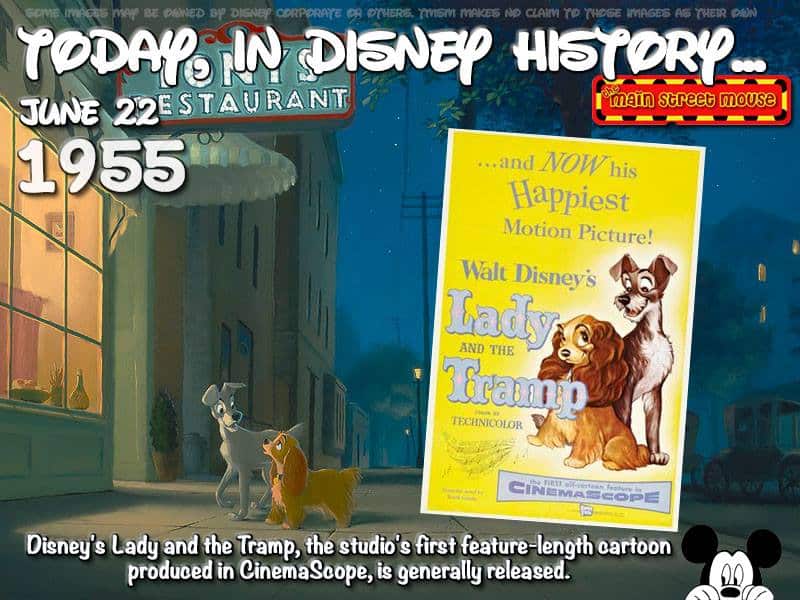Today In Disney History ~ June 22nd
Lady and the Tramp is a 1955 American animated romantic musical comedy film produced by Walt Disney and released to theaters on 22 June 1955, by Buena Vista Distribution. The 15th Disney animated feature film, it was the first animated feature filmed in the CinemaScope widescreen film process. Based on Happy Dan, The Whistling Dog by Ward Greene, Lady and the Tramp tells the story of a female American Cocker Spaniel named Lady who lives with a refined, upper-middle-class family, and a male stray mutt named Tramp. When the two dogs meet, they embark on many romantic adventures.
As they had done with deer on Bambi, the animators studied many dogs of different breeds to capture the movement and personality of dogs. Although the spaghetti eating sequence is probably now the best known scene from the film, Walt Disney was prepared to cut it, thinking that it would not be romantic and that dogs eating spaghetti would look silly. Animator Frank Thomas was against Walt’s decision and animated the entire scene himself without any lay-outs. Walt was impressed by Thomas’s work and how he romanticized the scene and kept the scene in.On viewing the first take of the scene, the animators felt that the action should be slowed down, so an apprentice trainee was assigned to create “half numbers” in between many of the original frames.
Originally, the background artist was supposed to be Mary Blair and she did some inspirational sketches for the film. However, she left the studio to become a children’s book illustrator in 1953. Claude Coats was then appointed as the key background artist. Coats made models of the interiors of Jim Dear and Darling’s house, and shot photos and film at a low perspective as reference to maintain a dog’s view. Eyvind Earle (who later became the art director of Disney’s Sleeping Beauty) did almost 50 miniature concept sketches for the Bella Notte sequence and was a key contributor to the film.
Originally, Lady and the Tramp was planned to be filmed in a regular full frame aspect ratio. However, due to the growing interest of widescreen film amongst movie-goers, Disney decided to animate the film in CinemaScope making Lady and the Tramp the first animated feature made in the process. This new innovation presented additional problems for the animators: the expansion of space created more realism but gave fewer closeups. It also made it difficult for a single character to dominate the screen so that groups had to be spread out to keep the screen from appearing sparse. Longer takes become necessary since constant jump-cutting would seem too busy or annoying. Layout artists essentially had to reinvent their technique. Animators had to remember that they had to move their characters across a background instead of the background passing behind them. Yet the animators overcame these obstacles during the action scenes, such as Tramp killing the rat.
More problems arose as the premiere date got closer since not all theaters had the capability to show CinemaScope at the time. Upon learning this, Walt issued two versions of the film: one in widescreen, and another in the Academy ratio. This involved gathering the layout artists to restructure key scenes when characters were on the edges of the screen.
A direct-to-video sequel, Lady and the Tramp II: Scamp’s Adventure, was released in 2001.
You can purchase your own copy of Disney’s Lady and the Tramp on DVD on Amazon!
 TMSM Today in Graphic by Sherry Rinaldi DeHart; Wiki
TMSM Today in Graphic by Sherry Rinaldi DeHart; Wiki - EPCOT Food & Wine Fest Dates, Details Announced - April 23, 2024
- Daydream Believing! - April 19, 2024
- Disney Adventure World: Disneyland Paris Reimagines 2nd Park - April 12, 2024




